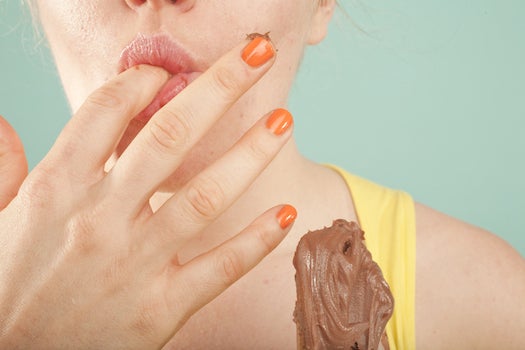Why We Can’t Stop Eating Frosting From The Can
Your brain makes you unconsciously like caloric foods even if they're not delicious, study finds.

You know when you’re eating frosting straight out of the can and you’re thinking, “I don’t even really like this flavor,” but you keep on eating? (It’s a dark, but human, moment. We understand.) Well, now one study is offering an explanation for why. Compared to calorie-free foods, foods with calories in them hit the human brain with big effects, even if people don’t appear to consciously like the flavors all that much.
There appear to be two unrelated brain circuits that kick into gear when people consume things, Dana Small, a Yale University psychologist who studies people’s responses to food and one of the scientists who performed this study, tells Popular Science. There’s one that’s related to consciously liking flavors. And then there’s another that responds to glucose in the blood, which is an indicator of that person’s metabolism of food. “The thing the brain really cares about are the calories,” Small says.
Small’s study comes after a few years of research into mice, rats and fruit flies have found that the animals are able to sense nutrition independently of taste. Over and over, researchers have genetically engineered lab animals not to be able to taste sweetness, and yet, over time, the animals learn to prefer mixtures containing real sugar instead of artificial sweetener.
Over time, animals learn to prefer mixtures containing real sugar instead of artificial sweetener.
You can’t genetically engineer a person not to be able to taste, so Small and her research team instead had people drink artificially flavored drinks. Some of the drinks were calorie-free, while others contained maltodextrin, a carbohydrate that people can’t taste, but still has calories.
In a series of experiments, the Yale psychologists found that over three weeks’ time, people come to like the flavor paired with maltodextrin more, even though they couldn’t taste the added carbohydrate. Still, they only increased their liking from “mildly pleasant” at the start of the study to “moderately pleasant” at the end of the study.
The researchers saw a larger effect when they took functional magnetic resonance imaging scans of people’s brains while they sipped the different flavors. Although they gave everyone 112.5 calories’ worth of maltodextrin in their caloric drinks, different people have different metabolisms, so people’s blood sugar levels differed after drinking their maltodextrin drink. The researchers saw that two regions in the brain, the hypothalamus and the nucleus accumbens, responded to the drinks in such a way that people with more blood glucose after drinking had more of a brain response. Small has done other research that suggests that responses in the hypothalamus and nucleus accumbens are related to risk for obesity.
Meanwhile, the hypothalamus and nucleus accumbens responses weren’t related to how much people said they liked their drinks. “Overall, the results suggested that there’s a real tight metabolic control of flavor reinforcement,” Small says. “So it’s metabolism controlling the mind, in a way.” Pretty weird.
Small’s idea is that people who overeat don’t necessarily like calorie-dense foods more. Instead, some people may be more at risk for overeating because their blood glucose levels—and brains—are reacting more strongly than other people’s. This isn’t an idea for the textbooks yet. People are still working out the exact mechanisms in mice, much less people.
Still, Small thinks it makes evolutionary sense. “All of these brain circuits evolved millions of years ago in animals that lacked consciousness but still needed to incorporate fuel,” she says. “From our research, it appears that those unconscious circuits that are caring about that energy are alive and well in our brains.”
You can find her new study in the journal Current Biology.